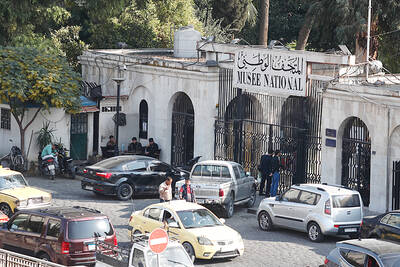One of the most intriguing mysteries in French history will be put to rest today when the heart of Louis XVII, child heir to the throne, is buried 209 years after his death in the royal crypt outside Paris.
European royals are expected to attend the funeral at the Saint-Denis basilica north of Paris, when the tiny organ kept in a crystal vase will be laid to rest near the remains of his parents, Louis XVI and Marie-Antoinette.
Louis-Charles, the so-called "lost dauphin" who would have reigned as Louis XVII, died at the age of 10 on June 8, 1795, in the French capital's Temple prison, with tuberculosis the official cause.
But his death has been the source of rumors and speculation for more than two centuries, with historians musing about the would-be king's fate until DNA tests proved the heart belonged to a Hapsburg, like Marie-Antoinette.
It's no small wonder that the death led to controversy: Louis XVII's heart was cut from his body, preserved, stolen, recovered and passed around for centuries before finding its way back to France.
Louis XVII was imprisoned with his parents and his sister in 1792 during the French Revolution. Once his parents were sent to the guillotine, Louis and his sister were separated, with the heir confined to a cramped, windowless cell.
Upon his death, the body of the child was ditched in a mass grave, but the doctor who performed the autopsy first cut out his heart and kept it in an alcohol-filled vase on his bookshelves.
He boasted of his possession to one of his students, who swiped the prize. Years later, after the thief died of tuberculosis himself, his widow returned the heart to the doctor.
The physician tried for many years to return the heart to members of the Bourbon family but was thwarted by royal squabbles. Louis XVII's remains finally found their way to the Spanish Bourbons, and eventually back to France.
Some historians and conspiracy theorists have seized on the amazing journey of the heart to argue that maybe it did not belong to Louis XVII after all, suggesting that instead of dying in prison, he had escaped or been spirited out of France to safety, and that the heart belonged to another child.
In the 19th century, several pretenders to the throne surfaced, including a German clockmaker named Karl Wilhelm Naundorff. Although he never claimed it himself, many thought US naturalist John James Audubon was the long-lost heir.
In 2000, scientists conducted DNA tests to put the rumors to rest. Result: the heart indeed belonged to a descendant of Marie-Antoinette.
Those who wanted to keep the "lost dauphin" myth alive argued that the heart could belong to Louis-Xavier-Joseph, Louis XVII's older brother who died in 1789.
But the heart of the older brother had been properly embalmed according to royal custom, while the one that had been examined -- that of Louis XVII -- had not. For historians, the debate was over.
"This is a way to give this child-martyr, who passed away in tragic circumstances and around whom mystery swirled for more than 200 years, a proper death," said Charles-Emmanuel de Bourbon-Parme, one of Louis XVII's relatives.
On Monday, the urn containing the heart -- which has been on display for 20 years at the Saint-Denis basilica -- will be transported to the Saint Germain l'Auxerrois church near the Louvre, once the royal parish, for a requiem mass.
Some 500 VIPs are expected to attend today's funeral mass at Saint-Denis, followed by the burial. Avid royal watchers not on the guest list can watch the ceremonies on two big-screen televisions outside the basilica.

Philippine President Ferdinand Marcos Jr yesterday vowed that those behind bogus flood control projects would be arrested before Christmas, days after deadly back-to-back typhoons left swathes of the country underwater. Scores of construction firm owners, government officials and lawmakers — including Marcos’ cousin congressman — have been accused of pocketing funds for substandard or so-called “ghost” infrastructure projects. The Philippine Department of Finance has estimated the nation’s economy lost up to 118.5 billion pesos (US$2 billion) since 2023 due to corruption in flood control projects. Criminal cases against most of the people implicated are nearly complete, Marcos told reporters. “We don’t file cases for

A feud has broken out between the top leaders of the far-right Alternative for Germany (AfD) party on whether to maintain close ties with Russia. The AfD leader Alice Weidel this week slammed planned visits to Russia by some party lawmakers, while coleader Tino Chrupalla voiced a defense of Russian President Vladimir Putin. The unusual split comes at a time when mainstream politicians have accused the anti-immigration AfD of acting as stooges for the Kremlin and even spying for Russia. The row has also erupted in a year in which the AfD is flying high, often polling above the record 20 percent it

Ecuadorans are today to vote on whether to allow the return of foreign military bases and the drafting of a new constitution that could give the country’s president more power. Voters are to decide on the presence of foreign military bases, which have been banned on Ecuadoran soil since 2008. A “yes” vote would likely bring the return of the US military to the Manta air base on the Pacific coast — once a hub for US anti-drug operations. Other questions concern ending public funding for political parties, reducing the number of lawmakers and creating an elected body that would

‘ATTACK ON CIVILIZATION’: The culture ministry released drawings of six missing statues representing the Roman goddess of Venus, the tallest of which was 40cm Investigators believe that the theft of several ancient statues dating back to the Roman era from Syria’s national museum was likely the work of an individual, not an organized gang, officials said on Wednesday. The National Museum of Damascus was closed after the heist was discovered early on Monday. The museum had reopened in January as the country recovers from a 14-year civil war and the fall of the 54-year al-Assad dynasty last year. On Wednesday, a security vehicle was parked outside the main gate of the museum in central Damascus while security guards stood nearby. People were not allowed in because